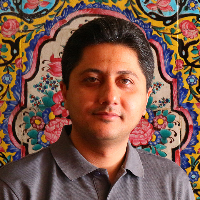Phenomenology of Garden in Assyrian Documents and Reliefs; Concepts and Types
Author(s):
Article Type:
Research/Original Article (دارای رتبه معتبر)
Abstract:
Problem: The Assyrian reliefs, especially the Neo-Assyrian, in addition to "historical narratives," have a long tradition in "representing the natural environment." On the other hand, Assyrian dipole ontology based on the "center/periphery" and "order/chaos" dichotomy has been influential in their naturalistic way of life and has shaped their aesthetic understanding. However, the role of these in shaping the garden as a third nature is a major issue in the Assyrian documents and reliefs, which has been considered less as an independent research, and no model has been presented.Goals: The purpose of this paper is to identify the key factors affecting the formation of gardens in the Neo-Assyrians and their typology and modeling their view of the garden and its various functions based on the analysis of research texts and surviving reliefs.
Research
Research
Method
This research based on a qualitative method in a critical and inferential approach and with an explicit reading of the phenomenology of the garden in the lands of Neo-Assyrians. The "triangulation of data" has been used to achieve theoretical saturation.Conclusion
The results show that gardens with the Assyrians are manifestations of the "microcosm" and include a spectrum of recreational-dramatic functions, including occasional, even ecological and economic ones. The typology proposed in this paper based on the location-operation of (a) gardens and parks in the urban landscape, and (b) gardens and parks of the urban fringe. The conceptual model, show that by moving away from downtown and decreasing gardens ritual and religious values, geometric and regular design changes to a free (natural) approaches landscape planningThe change in the paradigm of garden design based on the change of the garden from "Kirū" to "Kirimāhu" means the succession of dramatic gardens (fun and pleasure) instead of functional gardens (botanical) at the time of Sargon II (late 8th century BC), and this is The golden age in the Assyrian gardens, the elements of the dramatic art such as artificial lakes, Bitānu, and Aqueducts were added to the gardens and hanging and stepped gardens were flourishing. Keywords:
Typology , Assyrian gardens , Reliefs , Bitānu , Hunting
Language:
Persian
Published:
Bagh-e Nazar, Volume:15 Issue: 60, 2018
Pages:
51 to 62
magiran.com/p1834044
دانلود و مطالعه متن این مقاله با یکی از روشهای زیر امکان پذیر است:
اشتراک شخصی
با عضویت و پرداخت آنلاین حق اشتراک یکساله به مبلغ 1,390,000ريال میتوانید 70 عنوان مطلب دانلود کنید!
اشتراک سازمانی
به کتابخانه دانشگاه یا محل کار خود پیشنهاد کنید تا اشتراک سازمانی این پایگاه را برای دسترسی نامحدود همه کاربران به متن مطالب تهیه نمایند!
توجه!
- حق عضویت دریافتی صرف حمایت از نشریات عضو و نگهداری، تکمیل و توسعه مگیران میشود.
- پرداخت حق اشتراک و دانلود مقالات اجازه بازنشر آن در سایر رسانههای چاپی و دیجیتال را به کاربر نمیدهد.
In order to view content subscription is required
Personal subscription
Subscribe magiran.com for 70 € euros via PayPal and download 70 articles during a year.
Organization subscription
Please contact us to subscribe your university or library for unlimited access!



